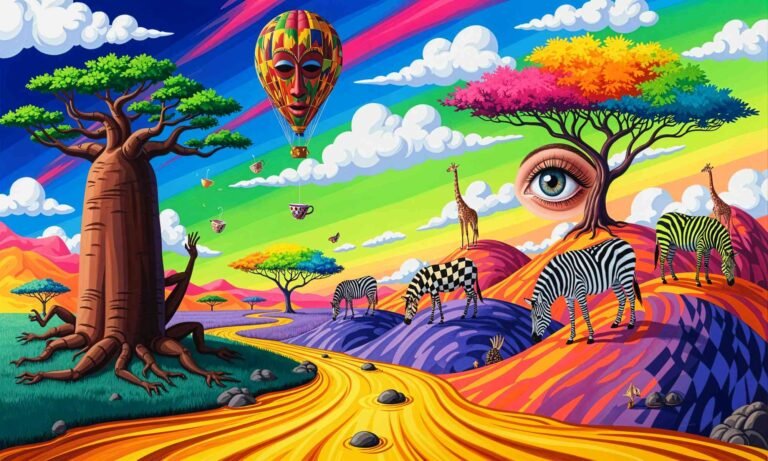Hermann Hesse (1877–1962) was a German-Swiss poet, novelist, and painter, known for his profound works exploring themes of self-discovery, spirituality, and the human condition. His writing is characterized by a deep introspection and a search for authenticity, often reflecting his own life experiences and philosophical inquiries. Hesse’s literary contributions have left a lasting impact on readers worldwide, with his novels such as “Siddhartha,” “Steppenwolf,” and “The Glass Bead Game” being celebrated for their exploration of the human psyche and the quest for meaning. His works continue to inspire and resonate with those seeking deeper understanding and personal growth.
- Born: July 2, 1877, in Calw, Germany.
- Family: His parents were Christian missionaries, which influenced his early exposure to religious and philosophical ideas.
- Education: Hesse attended several schools but struggled with the rigid educational system. He eventually dropped out and worked in various jobs, including as a bookseller, which fueled his love for literature.
Early Works
- “Peter Camenzind” (1904): A novel that follows the journey of a young man seeking fulfillment and meaning in life, ultimately retreating from society to find solace in nature.
- “Beneath the Wheel” (1906): A novel that critiques the oppressive educational system and its impact on a sensitive young student, Hans Giebenrath, who struggles to balance his academic pressures with his personal well-being.
- “Gertrude” (1910): A novel that explores themes of love, art, and the complexities of human relationships through the story of a composer and his muse.
- “Rosshalde” (1914): A novel that explores the life of a successful artist, Johann Veraguth, who is estranged from his wife and struggles with his family dynamics while living on his estate, Rosshalde.
- “Knulp” (1915): A novel that follows the life of a wandering vagabond named Knulp, who reflects on his experiences and relationships as he journeys through life, embodying themes of freedom, individuality, and the search for meaning.
Mature Works
Demian (1919)
“Demian” is a novel by Hermann Hesse, first published in 1919. It is subtitled “The Story of Emil Sinclair’s Youth” and explores themes of self-discovery, duality, and the journey towards individuality. The novel is deeply influenced by Hesse’s interest in psychoanalysis and existential philosophy, reflecting his own personal and spiritual crises during the period of its writing.
Read More
“Demian” is a profound exploration of the journey towards self-discovery and the integration of dualities within the human psyche. Hermann Hesse’s use of symbolic imagery, mythological references, and psychological depth makes it a timeless piece of literature. The novel encourages readers to seek their own paths, embrace their inner complexities, and achieve a holistic understanding of themselves.
Plot Summary
- Emil Sinclair’s Childhood
- Emil Sinclair is a young boy from a respectable, middle-class family. He lives in a dualistic world, divided between the safe, orderly world of his parents (“the world of light”) and the dark, chaotic world of forbidden experiences (“the world of darkness”).
- Influence of Franz Kromer
- Sinclair falls under the influence of Franz Kromer, a bully who coerces him into lying and petty theft. This encounter exposes Sinclair to the darker side of life and initiates his inner conflict.
- Meeting Max Demian
- Max Demian is a mysterious and charismatic older boy who befriends Sinclair. Demian recognizes Sinclair’s inner turmoil and begins to guide him towards self-awareness and independence.
- Demian introduces Sinclair to alternative ways of thinking, including the idea that good and evil are interconnected and necessary for personal growth.
- Exploration of Self and Spirituality
- Under Demian’s influence, Sinclair starts to question societal norms and religious teachings, seeking his own path. He becomes fascinated by symbols and myths, particularly the story of Abraxas, a deity representing the unity of godly and satanic elements.
- Sinclair’s journey is marked by introspection and a series of spiritual and existential awakenings.
- Art and Romantic Encounters
- Sinclair discovers his passion for art, using it as a means to explore and express his inner self. He becomes infatuated with Beatrice, a figure of idealized beauty, who represents his aspirations and inner growth.
- He also encounters Pistorius, an organist and mystic, who deepens his understanding of spirituality and the significance of inner symbols.
- Climax and Transformation
- The novel reaches its climax during World War I, reflecting the broader social upheaval and the internal struggles of its characters. Sinclair and Demian’s relationship evolves, culminating in Sinclair’s realization of his own identity and his acceptance of the unity of opposites within himself.
- Conclusion
- The story ends on an ambiguous note, with Sinclair achieving a sense of self-realization and inner peace. Demian’s influence has been crucial in Sinclair’s journey, but it is ultimately Sinclair who must walk his path alone.
Themes
- Self-Discovery and Individuality
- The novel is fundamentally about Sinclair’s journey towards self-discovery and the development of his unique identity. It emphasizes the importance of breaking free from societal expectations to find one’s true self.
- Duality and Integration
- A central theme is the duality of human nature, represented by the worlds of light and darkness. The novel suggests that true self-understanding comes from integrating these opposing forces.
- Spiritual Awakening
- Sinclair’s journey is also a spiritual one, exploring various religious and mystical ideas. The concept of Abraxas, a god embodying both good and evil, symbolizes the novel’s exploration of spiritual duality.
- Influence and Mentorship
- The relationship between Sinclair and Demian highlights the role of mentorship in personal growth. Demian serves as a catalyst for Sinclair’s self-discovery, guiding him but not providing all the answers.
- Symbols and Myth
- The novel is rich with symbolic imagery and references to mythological and religious stories. These symbols serve as tools for Sinclair’s introspection and understanding of his inner world.
Characters
- Emil Sinclair: The protagonist, whose journey from innocence to self-awareness forms the core of the novel. He evolves from a naive boy into a self-aware individual.
- Max Demian: A mentor figure who guides Sinclair towards self-discovery. Demian embodies wisdom and the integration of light and dark elements.
- Franz Kromer: A bully whose coercion propels Sinclair into a deeper awareness of the world’s darker aspects.
- Beatrice: An idealized figure representing beauty and aspiration, inspiring Sinclair’s artistic and spiritual growth.
- Pistorius: An organist and mystic who further influences Sinclair’s understanding of spirituality and inner symbols.
Siddharta (1922)
“Siddhartha” is a novel by Hermann Hesse, first published in 1922. The book is set in ancient India and follows the spiritual journey of a man named Siddhartha during the time of the Buddha. The novel explores themes of self-discovery, enlightenment, and the integration of wisdom and experience.
Read More
“Siddhartha” is a profound exploration of spiritual awakening and the quest for inner peace. Hermann Hesse’s novel emphasizes the importance of individual experience and the integration of life’s diverse elements in the pursuit of enlightenment. Through Siddhartha’s journey, the novel presents a timeless message about the nature of true wisdom and the path to self-realization.
Plot Summary
- Siddhartha’s Early Life
- Siddhartha is the son of a Brahmin and is expected to follow in his father’s footsteps. Despite his father’s teachings, Siddhartha feels unfulfilled and restless.
- Along with his close friend Govinda, Siddhartha leaves his home to join a group of ascetics called the Samanas, who practice severe self-discipline and asceticism in the pursuit of spiritual enlightenment.
- Encounter with the Buddha
- After years with the Samanas, Siddhartha and Govinda hear about Gautama, the Buddha, and decide to visit him.
- Govinda becomes a disciple of the Buddha, but Siddhartha believes that enlightenment cannot be taught and must be experienced personally. He leaves Govinda and continues his own journey.
- Worldly Life and Sensual Experiences
- Siddhartha meets Kamala, a beautiful courtesan, and becomes her lover. He learns the art of love from her.
- He also becomes a successful merchant under the guidance of Kamaswami. Despite his material success, Siddhartha grows increasingly disillusioned with his life of indulgence.
- Return to the River
- Realizing the futility of his pursuits, Siddhartha leaves the city and contemplates suicide. However, he finds solace by a river and decides to live by it.
- He meets the ferryman Vasudeva, who becomes his spiritual guide. Siddhartha learns to listen to the river and finds wisdom in its timeless flow.
- Enlightenment
- Over time, Siddhartha achieves a deep sense of peace and understanding. He realizes that enlightenment comes from embracing life’s experiences and finding unity in the contradictions of existence.
- In his old age, Siddhartha is visited by Govinda, who is still seeking enlightenment. Siddhartha shares his insights with him, emphasizing the importance of experiential wisdom over doctrinal teachings.
Themes
- The Search for Self -> The central theme of “Siddhartha” is the protagonist’s journey to find his true self. Siddhartha’s quest for spiritual fulfillment represents the universal search for identity and purpose.
- Wisdom vs. Knowledge -> The novel distinguishes between intellectual knowledge and experiential wisdom. Siddhartha learns that true understanding comes from personal experience rather than second-hand teachings.
- The Unity of Opposites -> Siddhartha’s enlightenment involves recognizing the unity of all things, understanding that opposites like joy and sorrow, life and death, are interconnected parts of a greater whole.
- The Role of Nature -> The river serves as a powerful symbol in the novel, representing the flow of life, constant change, and the unity of existence. Siddhartha’s enlightenment is closely tied to his communion with the river.
Characters
- Siddhartha: The protagonist, whose quest for enlightenment drives the narrative. He evolves from a curious youth to a wise, enlightened man.
- Govinda: Siddhartha’s childhood friend who becomes a follower of the Buddha. His path contrasts with Siddhartha’s, emphasizing different approaches to spiritual fulfillment.
- Kamala: A courtesan who teaches Siddhartha about love and desire. Her relationship with him represents the importance of sensual and emotional experiences in his journey.
- Vasudeva: The humble ferryman who becomes Siddhartha’s mentor. His deep connection with the river symbolizes the wisdom Siddhartha seeks.
Steppenwolf (1927)
“Steppenwolf” is a novel by Hermann Hesse, first published in 1927. The book is a complex, introspective narrative that explores themes of duality, self-identity, and the struggle between the individual’s instinctual desires and societal expectations. It is often considered one of Hesse’s most influential works, delving deeply into the psychological and existential crises of its protagonist.
Read More
“Steppenwolf” is a rich, multi-layered novel that delves into the complexities of the human psyche and the quest for self-understanding. Hermann Hesse’s exploration of duality, alienation, and personal transformation makes it a profound work that continues to resonate with readers. Through Harry Haller’s journey, Hesse offers insights into the nature of identity, the importance of embracing all aspects of oneself, and the potential for achieving inner harmony amidst the chaos of modern life.
Plot Summary
- Harry Haller -> The protagonist, Harry Haller, is a middle-aged intellectual living in Germany. He refers to himself as the “Steppenwolf,” symbolizing his divided nature—half man, half wolf. This duality represents his struggle between his cultured, human side and his wild, instinctual side.
- Life in Isolation -> Harry is deeply alienated from society, finding little solace in the conventional pursuits of his contemporaries. He lives a reclusive life, plagued by depression and suicidal thoughts. He despises the bourgeois values around him and struggles with a profound sense of meaninglessness.
- The Treatise on the Steppenwolf -> Harry finds a pamphlet titled “Treatise on the Steppenwolf,” which appears to be a profound analysis of his own personality and internal struggles. The treatise explains the dual nature of the Steppenwolf, outlining Harry’s inner conflicts and his potential for achieving a higher state of consciousness.
- Hermine -> Harry’s life begins to change when he meets a mysterious woman named Hermine. She becomes a guide for him, introducing him to new experiences and encouraging him to embrace both sides of his nature. Hermine represents a bridge between Harry’s divided self, helping him explore parts of his personality he has long suppressed.
- The Magic Theater -> Hermine introduces Harry to a world of sensual pleasures, including dance, music, and love. Eventually, she leads him to the “Magic Theater,” a surreal, dreamlike place that serves as the climax of Harry’s journey. Here, Harry confronts various aspects of his personality and experiences profound transformations.
- Confrontation and Resolution -> In the Magic Theater, Harry encounters symbolic figures and scenarios that force him to confront his inner turmoil. Through these experiences, he gains insight into his own nature and the possibility of integrating the conflicting parts of his personality. The novel ends on a note of ambiguous hope, suggesting that Harry may be on the path to self-acceptance and inner harmony.
Themes
- Duality and Integration -> The central theme of “Steppenwolf” is the exploration of duality within the human psyche. Harry Haller’s struggle between his human and wolf-like tendencies reflects the broader conflict between civilization and primal instinct.
- Alienation and Isolation -> Harry’s sense of alienation from society is a key theme. His intellectual and emotional detachment highlight the existential crisis of modern man, struggling to find meaning and connection in a seemingly indifferent world.
- The Search for Self -> The novel is a journey of self-discovery. Harry’s experiences, guided by Hermine, lead him to confront and understand the multifaceted nature of his identity.
- Transformation and Enlightenment -> “Steppenwolf” suggests that personal growth and enlightenment come from embracing and integrating all aspects of oneself. The Magic Theater symbolizes this transformative journey, where Harry learns to transcend his inner conflicts.
- Art and Sensuality -> The novel emphasizes the importance of art, music, and sensual experiences as pathways to understanding and reconciling the complexities of the human soul. Hermine’s influence on Harry highlights this theme.
Characters
- Harry Haller (Steppenwolf) -> The protagonist, whose inner turmoil and existential angst drive the narrative. His divided nature symbolizes the conflict between societal norms and individual desires.
- Hermine -> A charismatic and enigmatic figure who guides Harry on his journey of self-discovery. She helps him explore his repressed desires and facilitates his transformation.
- Pablo -> A saxophonist and friend of Hermine, representing the world of sensuality and pleasure. He introduces Harry to the liberating power of music and dance.
- Maria -> A lover who further helps Harry explore his sensual side. Her relationship with him is part of his journey towards understanding and integrating his desires.
Narcissus and Goldmund (1930)
“Narcissus and Goldmund” is a novel by the German-Swiss author Hermann Hesse, first published in 1930. The novel explores the contrasting paths of two central characters, Narcissus and Goldmund, against the backdrop of medieval Germany. The story delves into themes of spirituality, individuality, and the reconciliation of opposing elements within the human psyche.
Read More
“Narcissus and Goldmund” ultimately presents a harmonious vision of human existence, where the intellectual and the sensual are seen not as opposing forces but as complementary parts of a whole. Hesse’s novel is a profound meditation on the nature of human experience, the quest for meaning, and the integration of different facets of the self.
Plot Summary
- Narcissus -> Narcissus is a young, ascetic monk at the Mariabronn cloister. He is deeply intellectual, disciplined, and devoted to the pursuit of spiritual and philosophical knowledge. His life is characterized by order, self-control, and a commitment to the monastic ideals.
- Goldmund -> In contrast, Goldmund is a passionate and impulsive young man who comes to the cloister as a student. Under Narcissus’ guidance, Goldmund initially tries to adapt to the monastic life. However, he soon realizes that his true nature yearns for artistic and sensual experiences.
Themes
- Duality and Completeness -> The novel highlights the duality between the intellectual (Narcissus) and the sensual (Goldmund). While Narcissus represents the mind and spirit, Goldmund embodies the body and emotions. The story suggests that true fulfillment comes from integrating both aspects.
- The Search for Self -> Both characters are on a journey of self-discovery. Narcissus’ path is through introspection and asceticism, while Goldmund’s is through experiencing the world and expressing himself artistically.
- Art and Spirituality -> Goldmund’s journey underscores the idea that art is a form of spiritual expression. His artistic endeavors are depicted as attempts to capture the beauty and suffering of life, thus achieving a form of immortality.
- Mortality and Impermanence -> The novel reflects on the transient nature of life and the human desire to find meaning and permanence amidst impermanence. Goldmund’s artworks serve as a testament to this struggle.
Characters
- Narcissus: Represents reason, intellect, and the spiritual quest. He is steadfast in his monastic duties but also deeply empathetic towards Goldmund’s struggles.
- Goldmund: Embodies the artistic and sensual aspects of life. His journey is one of exploration, marked by love affairs, artistic creation, and existential questioning.
The Glass Bead Game (1943)
“The Glass Bead Game” (also known as “Magister Ludi”) is Hermann Hesse’s final novel, published in 1943. It is often considered his magnum opus, combining his lifelong interests in spirituality, intellectualism, and the quest for self-realization. The novel earned Hesse the Nobel Prize in Literature in 1946.
Read More
“The Glass Bead Game” is a rich, multi-layered novel that delves into the intricacies of intellectual life and the pursuit of personal and spiritual growth. Hermann Hesse uses the fictional world of Castalia and the metaphor of the Game to explore broader philosophical questions about the nature of knowledge, the purpose of education, and the quest for meaning. Knecht’s journey serves as a profound meditation on the need to balance intellectual pursuits with real-world experiences, ultimately advocating for a holistic approach to life.
Plot Summary
- Setting -> The novel is set in the distant future in a utopian society called Castalia, devoted to intellectual pursuits and the cultivation of knowledge. The central activity in this society is the Glass Bead Game, a highly sophisticated and symbolic game that synthesizes elements of various academic disciplines, including mathematics, music, logic, and philosophy.
- Protagonist -> Josef Knecht is the central character, whose life story the novel follows from his youth to his tenure as the Magister Ludi (Master of the Game). His journey is one of intellectual and spiritual development.
- The Glass Bead Game -> The Game is a form of intellectual synthesis, aiming to connect various fields of human knowledge into a harmonious whole. Mastery of the Game requires profound erudition and philosophical insight.
- Education and Rise -> Knecht is identified early on for his exceptional talents and is educated in the elite schools of Castalia. His dedication and intellectual prowess eventually lead him to become the Magister Ludi.
- Philosophical Journey -> Despite his success, Knecht begins to question the purpose and impact of the Game and the insularity of Castalian society. He seeks a deeper understanding of life beyond intellectual exercises.
- Departure from Castalia -> Knecht’s growing disenchantment with the limitations of the Game and the isolation of Castalia leads him to leave his position and the province. He wishes to engage more directly with the real world and its complexities.
- Final Chapter -> Knecht’s life outside Castalia is brief, and the novel ends with his sudden death while swimming. However, his journey symbolizes a broader quest for a balanced life that integrates intellectual pursuits with practical experience.
Themes
- Intellectualism vs. Practical Life -> The novel explores the tension between intellectual endeavors and practical engagement with the world. Castalia represents intellectual purity, while Knecht’s departure signifies the need to balance thought with action.
- The Search for Meaning -> Knecht’s journey is a quest for deeper meaning and fulfillment, beyond the confines of the Game and academic life. This reflects Hesse’s broader exploration of self-realization and spiritual awakening.
- The Role of Education -> The novel examines the purpose and limitations of education. Castalia’s rigorous intellectual training contrasts with the experiential learning Knecht seeks later in life.
- Unity and Synthesis -> The Glass Bead Game itself symbolizes the human desire to find unity and coherence in the diversity of knowledge and experience. The Game’s synthesis of disciplines represents an ideal of harmonious integration.
- Individual vs. Society -> Knecht’s individual quest for truth and authenticity often conflicts with the expectations and norms of Castalian society. This highlights the challenges of maintaining personal integrity within a structured community.
Characters
- Josef Knecht: The protagonist, whose intellectual and spiritual development is the focus of the novel. His journey from a dedicated student to the questioning Magister Ludi embodies the central themes of the book.
- The Magister Musicae: Knecht’s mentor, who represents the ideal of intellectual mastery and artistic integration.
- Tegularius: A brilliant but neurotic scholar in Castalia, contrasting with Knecht’s more balanced approach to life.
- Designori: A friend of Knecht from outside Castalia, representing the practical world and its challenges, influencing Knecht’s decision to leave the order.
Themes and Influence
- Search for Self-Discovery: Many of Hesse’s protagonists embark on journeys of self-discovery, reflecting his own lifelong quest for identity and meaning.
- Spirituality and Religion: Hesse’s works often explore spiritual themes, influenced by his upbringing and interest in Eastern religions.
- Duality and Integration: His novels frequently deal with the duality of human nature, emphasizing the need to integrate opposing elements within oneself.
- Alienation and Society: Hesse addresses the alienation of the individual in modern society, highlighting the tension between personal authenticity and social conformity.
- Art and Intellectual Pursuits: His novels celebrate the importance of art, music, and intellectual endeavors as means of personal and spiritual growth.
Personal Life and Legacy
- Marriages: Hesse was married three times, each marriage reflecting different phases of his life and emotional states.
- Mental Health: He experienced several periods of depression and underwent psychoanalysis with J.B. Lang, a student of Carl Jung. This influenced his writing, particularly the exploration of the unconscious mind.
- Later Years: Hesse spent much of his later life in Montagnola, Switzerland, where he continued to write and paint.
Awards and Recognition
- Nobel Prize in Literature: Awarded in 1946 for his inspired writings which, while growing in boldness and penetration, exemplify the classical humanitarian ideals and high qualities of style.
- Goethe Prize: Received in 1946, acknowledging his literary achievements.
Hermann Hesse’s works gained renewed popularity during the 1960s counterculture movement, resonating with readers seeking spiritual and existential insights. His literary legacy is marked by his profound exploration of the human soul and the perennial quest for meaning. His works continue to inspire readers with their deep psychological insights, spiritual depth, and eloquent expression of the complexities of human experience. Moreover, Hesse’s writings have become timeless treasures, offering solace and enlightenment to those who ponder the intricacies of existence and the journey of self-discovery.
What’s More
The posts in My Blog feature reflective, story-driven pieces rooted in personal and societal insights.
The topics in My Interests explore abstract, philosophical ideas and their cultural and societal impact.
👁️ 9,119 Views
















